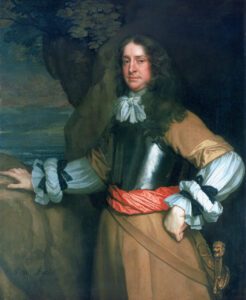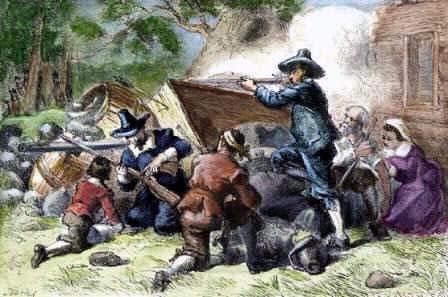Bacon’s Rebellion is a little-known event in Virginia colonial history. It was the first armed rebellion in the North American colonies in which discontented frontiersman took part. It was led by Nathaniel Bacon against Royal Governor Sir William Berkeley after Berkeley refused Bacon’s request to drive all Indians out of Virginia and his refusal to share his corrupt income. Hundreds of lower-class Virginians joined Bacon. They drove Berkeley out of Jamestown and torched the settlement. Bacon died while still in Jamestown and the rebellion was forcefully put down.
Since 1634 the Crown had reserved land in the Northern Neck of Virginia for Indians, but by the 1650s European colonists began squatting on this land. Armed clashes between settlers and Indians began and elements of four tribes moved into the area to help the local tribes defend their land. In July 1666, the colonists declared war on the Indians. By 1669 settlers had occupied land on the west of the Potomac River as far north as My Lord’s Island (now Theodore Roosevelt Island). By 1670 settlers had driven most of the Doeg Tribe out of Virginia into Maryland.

Bacon’s Rebellion was mainly a war between the wills of two ambitious and powerful men-William Berkeley and Nathaniel Bacon. Berkeley had been a courtier in the palace of Charles I of England. He was appointed royal governor of the profitable Virginia Colony in 1641 and established his own tobacco plantation (Green Spring House) near Jamestown among other elite planters.
Between1596 and 1646 there had been three Virginia wars with the Indians known as the Powhatan Wars. Berkeley led the attack that ended the third war. The peace treaty contained provisions giving him and his friends a monopoly on the deerskin and fur trade.
After King Charles I was executed in 1649 Berkeley offered safe haven to his Royalists friends. The new government censured him, and he resigned his governor position in 1652. He was allowed to keep his lands and he continued the profitable trade with the Indians.
Berkeley was reinstated governor in 1660 following the return of the monarchy in England and the coronation of King Charles II. Berkeley continued the monopolistic and profitable trade he had with the Indians and the flow of money continued. Berkeley did not share his profits with anyone.

Nathaniel Bacon was no poor struggling farmer. He was the son of wealthy landowners in England and was well-connected. He was related to William Berkeley by marriage. He spent his youth at Cambridge University and traveling through Europe on family money. In 1663 he was accused of cheating an acquaintance out of his inheritance. Rather than face the consequences, his father sent him to Virginia with a considerable sum of money. Bacon purchased land in the elite plantation area near Jamestown. Berkeley appointed the well-connected Bacon to his council.
The privileged class in Virginia owned the best land for the cultivation of tobacco, which was the most profitable cash crop. To avoid the “common people” the best land was sold only to men of their elite class, and they maintained their status by controlling politics. The big planters controlled nearly everything in Virginia.
By 1675 many indentured servants, both white and black, had completed their terms of service and now owned small farms throughout Virginia, particularly in the western frontier. Their land was less fertile than that owned by the elite planter class, so they had to work harder to make a smaller profit. In addition, more people were arriving from Europe every year, and many were settling on land that had been promised to the Indians. This situation caused an increasing number of Indian raids on small farms in the interior.

In July, Doeg warriors in Stafford County killed two settlers, burned fields, and killed cattle. Militia then killed ten Doeg warriors and 14 friendly Susquehannocks. Governor Berkeley declared the Susquehannock tribe was involved in the raids and Maryland militia killed five chiefs at the Susquehannock stronghold in Maryland. The Indians retaliated by killing 60 settlers in Maryland and 36 in Virginia. Other tribes joined in, killing settlers, burning houses, and killing livestock as far as the James and York Rivers.
Bacon pushed for the removal and wholesale slaughter of all Indians, but Berkeley, who was making lots of money trading with them, refused. Since Berkeley would not act, small farmers began to gather to organize their own raiding party. Bacon arrived with a large quantity of brandy. After the brandy was distributed, Bacon was elected leader.
Against Berkeley’s orders, Bacon’s party moved south and convinced Occaneechi warriors to attack the Susquehannocks. Once the warriors left, the settlers slaughtered all the men, women and children left in the village.
Upon their return, Bacon’s raiders found that Berkeley was calling for new elections to the House of Burgesses to address the Indian raids. The resulting actions by the Burgesses were not proactive against the Indians.
Bacon accused Berkeley of corruption. He charged that Berkely gave government positions only to friends and relatives (as he had with Bacon) and was profiting by trading with the Indians, which only upset Bacon because Berkeley would not share with him. He further accused Berkeley of enriching himself at taxpayer expense, which Bacon was likely doing too.
To make his charges public, Bacon issued his Declaration of the People of Virginia on 30 July 1676 accusing Berkeley with eight counts of corruption. Of course, Bacon did not mention that he had benefited from this corruption. He presented himself as a man of the people who was willing to fight for the small farmers against the tyranny of elitest tidewater planters. (Bacon was an elite tidewater planter.)
Berkeley denied any wrongdoing and declared Bacon guilty of treason. Bacon claimed he had no quarrel with the Crown so was not guilty of treason. He claimed he was only fighting against corruption and to protect small farmers.
By this time, Bacon had between 300 and 500 armed followers who had been promised freedom for indentured servants (they made up most of his followers), lower taxes, better land for freemen, and safety for farmers in the interior by eliminating the Indians. Black and white indentured servants, small farmers, and slaves had joined Bacon. He further stirred up class resentment by declaring all their problems were the fault of the wealthy landowners and their corrupt governor. He also claimed Berkeley valued Indian rights above those of English colonists.
Berkeley had to be under a lot of pressure from other tidewater planters to put a stop to Bacon’s movement because they saw it as a direct and real threat to their domination of all things in the colony. In addition to the threat of direct armed attack, Bacon’s followers were the classes of people who did the work on their plantations. Slavery as we know it did not yet supply most laborers on big plantations. Without this underclass of whites and blacks, the tidewater planters of the time could not maintain their easy lifestyle.
Bacon decided that he had exhausted all available “legal” avenues to get Berkeley to accept his methods, so he marched his army of followers to Jamestown. The elite planters must have been concerned about their safety when this large, armed, and unruly force moved through their lands.

There are two quite different accounts of what happened when Bacon’s army entered Jamestown. The account I believe is most likely is that Berkeley, his household, and outnumbered supporters fled Jamestown before Bacon’s army arrived. They retreated across the James River and encamped at Warner Hall, the home of the speaker of the House of Burgesses. Bacon besieged and captured Jamestown and then burned it to the ground on 19 September 1676.
The second version is more “heroic” and bombastic. When Bacon entered the town, he demanded a commission to lead militia against the Indians. Berkeley refused to yield and when Bacon had his men take aim at him, he “bared his breast” and told Bacon to shoot him. Bacon than had his men threaten the assembled Burgesses who quickly granted the commission. Bacon’s army burned the town on 19 September.
In both versions, Bacon’s men occupied the ruins of Jamestown and prepared for the expected counterattack by Berkeley. Before the attack came, Bacon died of “Bloody Flux” (dysentery). John Ingram took command, but he was not as charismatic as Bacon and the army began to dissipate and many men returned to their homes.
Berkeley, aided by armed English merchant ships, attacked, and defeated the remaining rebels. He hanged 23 of the leaders. Ingram was likely in that group. Following the clearing of Jamestown, Berkeley’s forces found and eliminated small pockets of resistance throughout the region.

Governor Berkeley felt he had handled Bacon’s Rebellion quite professionally, but King Charles II did not share this opinion. He sent Sir Herbert Jeffreys to order Berkeley back to England to explain himself. The meeting with the king probably would not have gone well but we will never know because Berkeley died shortly after reaching England.
Jeffreys, with 200 troops he brought to the colony, restored order in Jamestown. He then turned his attention to dismantling the power of the elite planters but died in 1678 before he could accomplish anything.
The elite planters, many of whom were members of the House Burgesses, realized they had come awfully close to losing their elite status and domination. They were determined to make sure nothing like Bacon’s Rebellion could occur again. First, they passed legislation to ban indentured servitude. It was obvious to them that this program had increased the number of small farms owned by disgruntled and armed citizens.
They also institutionalized black slavery and made Jamestown a major slave port. Slavery had been slowly increasing since the 1660’s, but the legislation caused the numbers to surge. In 1650 there were only 300 black slaves in the Chesapeake Bay area, but by 1700, there were at least 13,000.
The legislation’s new taxes purposely favored lower class whites over black freemen. Pitting poor whites against blacks, also pushed the whites closer to the wealthy planters, which further established a society based on racial lines. This way the whites and blacks would never band together again.
Bacon’s Rebellion also convinced the planters that they had to become leaders in armed conflicts against Indians. This was to establish camaraderie with their lower-class white subordinates while maintaining authority over them.
To further pander to the small farmers in the interior and to gain their loyalty, the House of Burgesses reinstated the Headright System. The Headright System promised any freeman 50 acres of land that had been taken from Indians. This encouraged more colonization and the slaughter of Indians on land the Indians had been promised by treaty.

Some historians regard Bacon’s Rebellion as a precursor to the War for American Independence and that Bacon as a great patriot. Thomas Jefferson was one of the believers and this view has continued, especially in Virginia, through the 20th century. It still appears in some textbooks.
The true motivations were less than noble. This was basically a war between two wealthy, elite landowners who were both jealous, stubborn, greedy, and corrupt. They were both fighting to obtain and retain their share of official corruption without sharing. Rather than a patriotic uprising, it was another example of English colonial greed with the Indians and blacks being the biggest losers.
